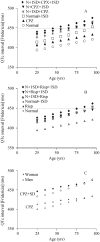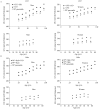Aging effects on QT interval: Implications for cardiac safety of antipsychotic drugs
- PMID: 24748877
- PMCID: PMC3981979
- DOI: 10.3969/j.issn.1671-5411.2014.01.005
Aging effects on QT interval: Implications for cardiac safety of antipsychotic drugs
Abstract
Objectives: To explore the effect of aging on cardiac toxicity specifically the interaction of age and antipsychotic drugs to alter the QT interval.
Methods: THE MEDLINE DATABASES WERE SEARCHED USING THE OVIDSP PLATFORMS WITH THE SEARCH STRATEGY: "QT interval" or "QT" and "age" or "aging". The entry criteria were: over 10,000 apparently healthy individuals with data on both sexes; QT interval corrected for heart rate (QTc) and an expression of its variance for multiple age decades extending into the older ages.
Results: QTc increased in duration with increasing age. Considering a modest one SD increment in QTc in the normal population, the addition of Chlorpromazine produced a QTc on average greater than 450 ms for ages 70 years and older. Risperidone, that did not on average alter QTc, would be expected to produce a QTc of 450 ms in persons in their mid 70 years under some circumstances. QTc prolongation > 500 ms with antipsychotic drugs is more likely for persons with QTc initially at the 99(th) percentile. It may occur with Haloperidol which does not on average alter QTc.
Conclusions: The range of values for the QT interval in apparently normal older men or women, when combined with the range of expected QT interval changes induced by antipsychotic drugs, can readily be associated with prolonged QTc. Individuals with QTc at the 99(th) percentile may have serious QTc prolongation with antipsychotic drugs even those that are not usually associated with QTc prolongation.
Keywords: Aging; Antipsychotic drugs; Cardiac safety; Psychotropic drugs; QT interval.
Figures


Similar articles
-
Proarrhythmic risk with antipsychotic and antidepressant drugs: implications in the elderly.Drugs Aging. 2009;26(12):997-1012. doi: 10.2165/11318880-000000000-00000. Drugs Aging. 2009. PMID: 19929028 Review.
-
Antipsychotic drugs and QT interval prolongation.Psychiatr Q. 2003 Fall;74(3):291-306. doi: 10.1023/a:1024122706337. Psychiatr Q. 2003. PMID: 12918603 Review.
-
New age- and sex-specific criteria for QT prolongation based on rate correction formulas that minimize bias at the upper normal limits.Int J Cardiol. 2014 Jul 1;174(3):535-40. doi: 10.1016/j.ijcard.2014.04.133. Epub 2014 Apr 21. Int J Cardiol. 2014. PMID: 24825030
-
Prevalence and correlates of QTc prolongation in Italian psychiatric care: cross-sectional multicentre study.Epidemiol Psychiatr Sci. 2016 Dec;25(6):532-540. doi: 10.1017/S2045796015000906. Epub 2015 Oct 15. Epidemiol Psychiatr Sci. 2016. PMID: 26467074 Free PMC article.
-
Impact of Age and Sex on QT Prolongation in Patients Receiving Psychotropics.Can J Psychiatry. 2015 May;60(5):206-14. doi: 10.1177/070674371506000502. Can J Psychiatry. 2015. PMID: 26174524 Free PMC article. Review.
Cited by
-
Incidence and outcomes of long QTc in acute medical admissions.Int J Clin Pract. 2018 Nov;72(11):e13250. doi: 10.1111/ijcp.13250. Epub 2018 Sep 17. Int J Clin Pract. 2018. PMID: 30222237 Free PMC article.
-
Inhaled hydroxychloroquine to improve efficacy and reduce harm in the treatment of COVID-19.Med Hypotheses. 2020 Oct;143:110110. doi: 10.1016/j.mehy.2020.110110. Epub 2020 Jul 15. Med Hypotheses. 2020. PMID: 33017904 Free PMC article.
-
Combined Effects of Age and Comorbidities on Electrocardiographic Parameters in a Large Non-Selected Population.J Clin Med. 2022 Jun 28;11(13):3737. doi: 10.3390/jcm11133737. J Clin Med. 2022. PMID: 35807018 Free PMC article.
-
Managing cardiovascular disease risk in patients treated with antipsychotics: a multidisciplinary approach.J Multidiscip Healthc. 2014 Oct 31;7:489-501. doi: 10.2147/JMDH.S49817. eCollection 2014. J Multidiscip Healthc. 2014. PMID: 25382979 Free PMC article. Review.
-
Nomenclature, categorization and usage of formulae to adjust QT interval for heart rate.World J Cardiol. 2015 Jun 26;7(6):315-25. doi: 10.4330/wjc.v7.i6.315. World J Cardiol. 2015. PMID: 26131336 Free PMC article. Review.
References
-
- Rabkin SW. Electrocardiographic abnormalities in apparently healthy men and the risk of sudden death. Drugs. 1984;28:28–45. - PubMed
-
- Elming H, Holm E, Jun L, et al. The prognostic value of the QT interval and QT interval dispersion in all-cause and cardiac mortality and morbidity in a population of Danish citizens. Eur Heart J. 1998;19:1391–1400. - PubMed
-
- Okin PM, Devereux RB, Howard B V, et al. Assessment of QT interval and QT dispersion for prediction of all-cause and cardiovascular mortality in American Indians: The Strong Heart Study. Circulation. 2000;101:61–66. - PubMed
LinkOut - more resources
Full Text Sources
